As an Amazon Associate I earn from qualifying purchases.
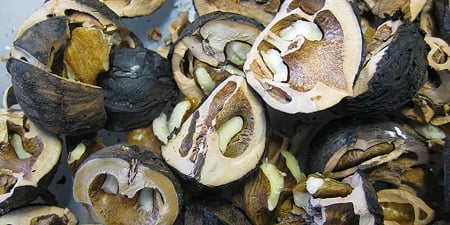
You’d think that if anything would bring out the Greed of Man in me, it would be truffles, a sexy, intoxicating food that can fetch $300 a pound or more. Yet I’ve given plenty of them away to my friends without a second thought.
No, what really makes me feel like Gollum from Lord of the Rings, the wild food I hold most precious, is my store of shelled black walnuts. Don’t even ask. You can’t have any. They are mine I tell you, all mine!
For those of you who don’t know what a black walnut is, it is a generic term for the wild walnuts native to North America. There is one main species east of the Rockies, two in California, and a couple of others in Arizona and Texas. Black walnuts are, more or less, related to hickory nuts and butternuts.
What’s the difference between black walnuts and the kind you get in the store? The vast majority of walnuts you buy in stores are English (also called Persian) walnuts, which are larger and easier to shell than black walnuts. In some places you can buy them in stores, and you can buy black walnuts online.
Size is not the main difference between black walnuts and domesticated ones. Flavor is. Black walnuts taste far stronger than regular ones: More concentrated, walnut-y, and even a touch more bitter.
To me they are the difference between cream and skim milk, grouse and chicken, a wild strawberry and one of those gigantic ones grown on the coast of California. I will take black walnuts over regular ones any time, and for any price.
Luckily that price is free: Black walnut trees grow all around us here in Northern California. My friend Josh tipped me off to a great spot, too, which has so many old trees it took my just 10 minutes to fill two 5-gallon buckets.
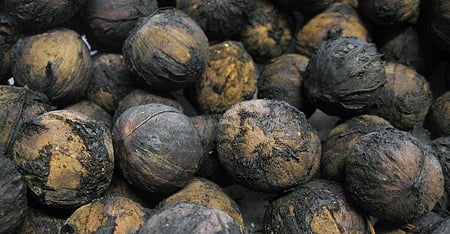
OK, maybe I lied. Black walnuts are not free — if you take time into consideration. Nothing I have ever done, not winemaking, gardening, big-game hunting, processing acorns or curing olives is as labor-intensive as harvesting, hulling and shelling black walnuts. As my fellow forager Connie Green says, “black walnuts are a fortress.” Here’s the method I figured out to storm the gates.
First you need to harvest the walnuts at the correct stage of ripeness.
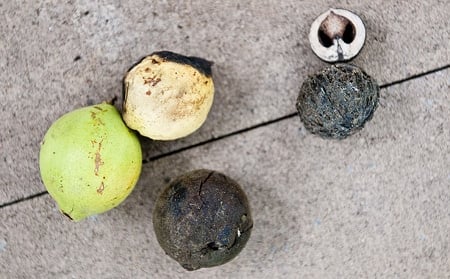
For starters, walnuts will probably not be ripe where you live until October, so wait until then to begin. November should be fine, too, and you can pick up fallen nuts from the ground around the trees into December, but by then our Little Gray Friends the squirrels will have had at them.
So you’re standing at a tree. You see all these forms of walnuts in front of you. Which to pick?
Green ones will most likely still be on the trees. Yes, you can collect them, but they have a surprise in store for you. The beige ones are rotting green ones — they are the hardest to work with, but the nut inside will still be fine. The black one at the bottom is how you will find most of your walnuts: It has its hull rotted and is pretty dry. Finally, if you’ve had lots of rain, you will find some nuts that will be pre-hulled, like the one under the half-shell.
Pick only pre-hulled walnuts that feel heavy for their size, as they will dry out in the shell once hulled.
For the most part, you will need to hull your walnuts. Lots of people say you should just drive over them with a car, but this stains your driveway. Stain? Why yes. Black walnut juice stains like nothing else. And it will not come off with any amount of scrubbing. If you fail to wear gloves when you hull black walnuts, you will have the Black Hand of Death for several days.
Sam Thayer, in his book Nature’s Garden, suggests stomping on the hulls in the field to get them off. This works, but incompletely in my experience with Northern California walnuts, Juglans hindsii. So I sit outside on my porch with three buckets — one with walnuts in it, one for the soon-to-be-hulled walnuts, and one for the hulls. I then don gloves and use a pocketknife to hull the nuts by hand.
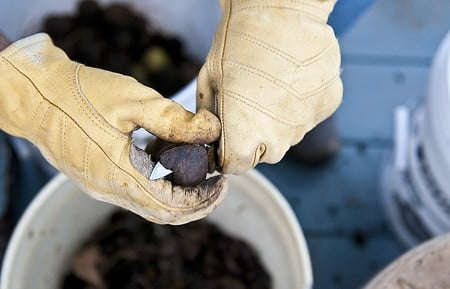
You want a relatively dull knife that you can slice with and not be in danger of it piercing your work gloves. The work can get a little slippery, especially with the green walnuts — remember the surprise? That’s it. A half-hulled green walnut is slipperier than goose shit on a doorknob. This is why I prefer the walnuts with the fully rotted black hulls.

Beware when you are hulling walnuts outdoors. Our Little Gray Friends could be lurking anywhere, just waiting to steal your walnuts for themselves. I use a biological countermeasure to keep the squirrels away:

Once hulled, your work has just begun. Now you must shell your walnuts.
This is the point at which you can kick back a bit. Hulled walnuts store well in the shell, and in fact crack better once they’ve dried for a few weeks.
Once you start shelling, however, you need to banish from your head all notions that you will be able to crack black walnuts and get those pretty perfect halves you can get with regular walnuts. Won’t happen. Bits and pieces are the price of precious black walnut meats.
I crack mine with a hammer, on the concrete floor of my garage. Such force is necessary. I’ve never heard of a regular nutcracker fierce enough to break a black walnut, although some people in the Midwest, where the Eastern species lives, have created special black walnut shellers. Anyone ever use one? I’ll buy one if they work well…
The key to the hammer technique is to use a terrycloth towel to cover the nuts, so the pieces don’t fly all over the room. Use a towel you don’t care about, as it will get holes. Smack the nut with enough force to break it, but not enough to pulverize the nut; after a few, you’ll get the hang of it.
So now you have a bucket of cracked nuts. You’re still not done! Now you need to gently remove the meats from the impossibly complex interior of the walnut. I find the best piece of equipment to do this is a stout pair of wire cutters and a nutpick. I use the wire cutters to clip the shells in key spots so larger pieces of walnut fall out. Again, after a few dozen nuts you’ll begin to know where to clip. The nutpick’s use is obvious. This is tedious work, people. I do it while watching football.
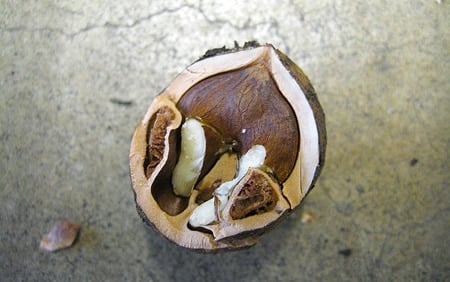
Let me tell you before you begin a black walnut adventure that you need to be patient. It took me probably six hours of work to get 15 ounces of nutmeats — although that includes hulling all of my nuts, not just the portion I cracked and picked. But all this work is worth it.
Just the aroma of black walnuts is payment for the effort: They smell toasted without actually being so. And I’ve already mentioned the flavor, which is so strong many recipes say just half the amount of black walnuts will fully replace the flavor of regular ones. I’m not so sure about that, but you can use a bit less. If you want.
Which brings me, finally, to what I do with my black walnuts. In holiday season, I make a Christmas cookie from my childhood:
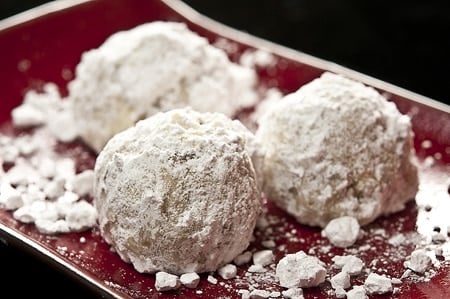
It is my version of a traditional walnut snowball cookie, also known as a Russian teacake or a Mexican wedding cake. My version has black walnuts, of course, but also orange flower water and a little orange liqueur. It’s an awesome cookie, a riff off one my mum has made for decades.
These cookies are stupid easy to make — no mixer necessary, just clean hands — and are so good you really need to make a double batch, because you will eat half of them before your friends or family come home. Trust me on this one.





Thanks for all the info. We have several wild black walnut trees in So California and will now try to harvest some using your experience and tips. It sure sounds like a lot of work, though 😉
Have a question that someone may be able to answer. I’m a novice when it comes to black walnuts. I hulled and set 20 some to dry and a week later got about 15 more and hulled them. I wanted to see the meat of the walnut so I cracked one that I had just hulled and it looked great, jelly like and needed drying, but looked great. My curiosity got the best of me and I cracked one that I had on the drying rack from a week ago. The nut meat was very very thin, almost like it was nothing, is that normal or just a bad walnut?? Any help would be appreciated.
Thanks
Nick
Why are you cracking nuts in July? Are they from last year? If they are this year’s nuts, they are not ready. If they are last year’s nuts, then yes, the thin one was a bad nut.
Great article! Thanks!
Wife (Ms Carmen) and I spent our first night at home on our ‘new’ old farm here in northeast Tennessee. We’ve named it “Eden’s Garden”, after the Eden family who established it in 1908.
Black walnut trees everywhere and they are COVERED!!
Looking forward to our harvest!
Does anyone want to sell any of your black walnuts? If so, have been dying to get some, just let me know.
I’ve found a good way to get the hulls off is to pound the nuts thro a knot hole or hole drilled in a board.
The taste is unique. Not sure if ‘earthy’ is good or bad…I personally love the flavor. It has been said that if you hull the nuts while they are still green, before the inside gets brown and squishy, that the flavor will be milder, and I believe this to be true from my own experience.
The very best, easily available way to crack them is with a ‘Vice Grips’, it is very controlled and can be easily adjusted with the screw adjustment from nut to nut.
Not sure if anyone is still around to answer since this is from 2010 but I harvested my first black walnuts, I picked them up from the ground as out trees are WAY too tall to pick them from. Some of the outer shells were black, some were speckled with black/brown, I took off the outer husk, washed them and let them air dry (as instructed in a video on youtube) …its been several weeks now and I decided to crack one open to have a taste…they taste like english walnuts but with a more earthy taste. Did I do something wrong? should I toast them before eating/using? or could my nuts just be bad?
My grandfather’s favorite cookie was a black walnut icebox cookie. I hadn’t made them for years, since they’re not to everyone’s taste, but now that we have our own black walnut tree in the Berkshires, we’ve been harvesting — mostly wresting them away from the rival teams of red squirrels, who secrete them on opposite sides of the orchard and then relocate them to their nests — and making the cookies for Christmas. [The squirrels have managed over the years to fill the sills of the house and barn with black walnut shells. How they get their tiny little teeth through the hardest shells in the world is anybody’s guess.] Recipe attached.
Ice Box Nut Cookies
(Black Walnut)
2 eggs
2 c brown sugar
1 c shortening (my mother used margarine; I use Earth Balance + butter)
Beat together and add:
3 to 3-1/2 c flour
1 t baking soda
pinch of salt
1 c nut meats, broken
Stir up at night, pack in shallow pan ungreased. Place in cold place. In the a.m. turn on floured board, slice thin, and bake.*
*375 for 10-12 min or till nicely browned and smelling like the earth and heaven combined
Great article. This is information you just can’t find. Sadly, people in Indianapolis just throw them away.
I harvest them – https://www.fallcreekgardens.org/2013/11/black-gold-black-walnut-harvest/
Great story, reminding me of my childhood in Lake Odessa, Michigan. We had 4 black walnut trees in our yard. Each year for Christmas we 5 kids would give our aunt (a professor who lived in Manhattan and was famous for her black walnut chocolate brownies) and grandmother a jar of black walnuts for Christmas. We accomplished this by our teenage-brother driving the car over them (we just had a dirt driveway) to get the hulls off. Then around the kitchen table he would hammer them open on a brick sitting on the kitchen table. We 3 sisters would take the nutmeats out using nutpicks. So much fun — and so appreciated by our aunt and grandmother!
I always wash the hulled nuts several times in a 5-gallon bucket (the wash water is slightly toxic to other plants so pour it somewhere other than your garden–I pour it on my gravel driveway). Then I hang the nuts in mesh bags for several weeks, up to 6 months to dry and cure. I crack them in a bench vise, which works better than a hammer and saves you a blue thumb. My dad used to say something was bluer than a cross-eyed carpenter’s thumb. Only hickory nuts are hard to crack and pick, but they are as delicious in their own right as black walnuts.
Hank,
I understand that the Native Americans used Black Walnut products for a lot of things including as a dye and insect repellent and I do know of one by-product use that could come in handy. If you’ll crush the hulls in some sort of bucket, add water and pour it over some ground that will potentially hold earthworms, the chemicals in the hulls will make ALL of the worms in that area come to the surface immediately for easy gathering to put on a hook! Have a container of clean water handy also to give the worms a rinse since the walnut juice obviously has an effect on them.
Happy gathering…and fishing together in this case!
Thanks Hank. Just what’s needed – the walnuts are falling.
All the above brings back fond memories of my Illinois childhood with Dad, hulling and shelling black walnuts. Now in Wisconsin, our little farm must have 50 trees and this year is a bumper crop. I could take hundreds of pounds and the squirrels wouldn’t notice.
We bought a trommel, a sort of rotary sieve, a couple years ago for sifting larger chunks out of compost. Its original use was as a field corn cleaner. It is basically a 40″ diameter drum about six feet long, covered in 1/2″ hardware cloth. A 1/4 HP motor drives it at maybe 30 rpm. It’s normally inclined a few degrees so the finer compost falls through for collection, while the undigested pieces of whatever make it to the lower end and fall out.
I blocked it up so it’s almost flat and put a temporary shield on the end. Then I dump a few dozen walnuts onto an unused sidewalk, walk on them wearing OUTDOOR ONLY boots until the hulls are loosened, then shovel the whole mess into the open end of the trommel. When there are several hundred nuts loaded, I let it run for about half an hour. It gets gradually louder as the hulls break up and fall through the screen. I stood back and shot a good stream from the garden hose into the rotating drum, ran it a bit more, then lowered the bottom end before removing the end shield, and watched the clean nuts fall into a bin.
I’ve run only two batches so far, but it seems to work pretty well. There are a lot more waiting to be done. And way more than I’ll ever get around to shelling.
I like the juxtaposition of “goose shit on a doorknob” with the cuter-than-cute kitty cat. Nice write up, Mr. Meat Guy.
So my dad keeps saying to wait until the black walnuts green flesh is completely rotted off and the nut is all that remains. I tried to get the goey black part off of some of them today and there were maggots. But they keep saying that if I don’t wait the nut will not come off on the inside once you break into them. I’m confused, because it doesn’t sound right to let the green or black flesh completely rot off. I would also like to attempt to make dye and jam. So I did peel some green ones and am playing boiling that water with the peeling. My question is do i let the walnuts green or black flesh completely rot off or do I go ahead and take the blacks or greens off?
Thank you for all of the help I just got some blacks today I hope from the advice I had gotten on shelling the nut shells I will try some of the techniques on the nuts I have gotten today. I have to start can’t wait
Hank, Thanks for the fun and informative read. I’m embarrassed to say, I’ve intended to harvest our huge black walnut tree for 15 years. Usually I get around to setting the nuts out to dry, and yes, the squirrels have a field day. This year I’m determined to get to the meat of the matter. I already have the black hand of death to prove it (the juice soaked right through my glove). Recently did a post on my love/hate relationship with our black walnut tree. https://melissashawsmith.com/2013/07/10/the-black-walnut/
Glad to have found your blog!
Hi Hank,
Great blog. I thought I would share my recent experience with Black Walnuts. I have a pizza oven in my backyard. I use it at night and the following morning the temperature inside is around 200 degrees F. It will hold that temp for 6-8 hours. I recently put several gallons of black walnuts in the oven and sealed it for 10 hours. At the end of that time the walnuts were black and somewhat dehydrated. However, the meat inside was still raw. This softened the husks and killed any worms that were inside. After that, I left them to dry a few more days and then began to remove the husk with a knife. They were not at all slippery, as can sometimes be the case. Once that was done, I cut the walnuts in half using a band saw. The cut ran between the stem end and the blossom end. Cutting them in this way allowed me to easily remove the meat. It is a nightmare to remove the meat if you cut through the stem and blossom end. Anyway, I thought I would pass these tips along as it made my job very easy compared to some of the stories I have read.
Carrie: Sorry, yer outta luck. Toss ’em or make nocino. The trick with pickling walnuts is to jam a stout needle or skewer through one: If it goes right through, you can make pickled walnuts. Around where I live it’s a Memorial Day kind of thing…